It seems we can’t find what you’re looking for. Perhaps searching can help.
Sign Up for newsletter!
Subscribe to get the latest eBook!
Hotline






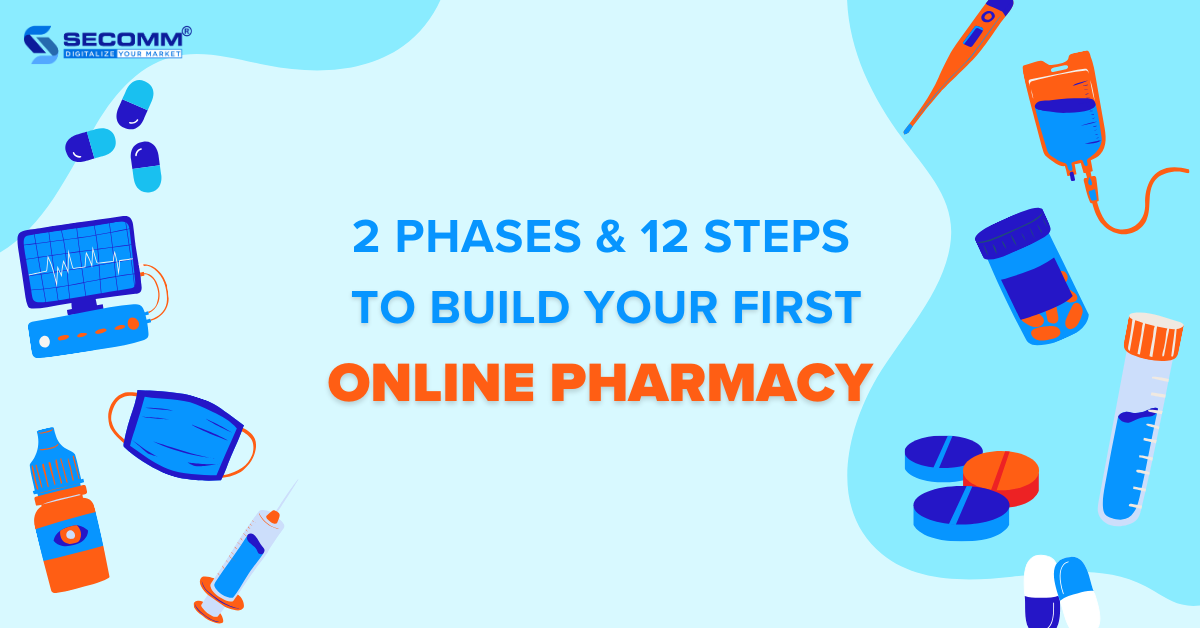
Since the advent of the COVID-19 pandemic, the pharmaceutical industry has proven the potential of transitioning from offline to online pharmacy. In the United States, the number of remote health consultations surged by 2,600% in March 2020 (during the peak of COVID-19 in the U.S.) compared to the same month in 2019. According to Statista, the global pharmaceutical eCommerce sector is projected to reach 32 billion USD by the end of 2023.
Several brands have successfully embraced eCommerce early on, achieving unexpected successes. Examples include Apollo Pharmacy (India), FPT Long Châu (Vietnam), CVS Health (USA), and Droga Raia (Brazil). The common thread among these brands lies in their comprehensive eCommerce platforms, catering to the shopping needs of customers for healthcare, pharmaceutical, and medical products.
With nearly 10 years of experience in the eCommerce sector, SECOMM has outlined the journey of building pharmaceutical eCommerce websites for the Vietnamese market.
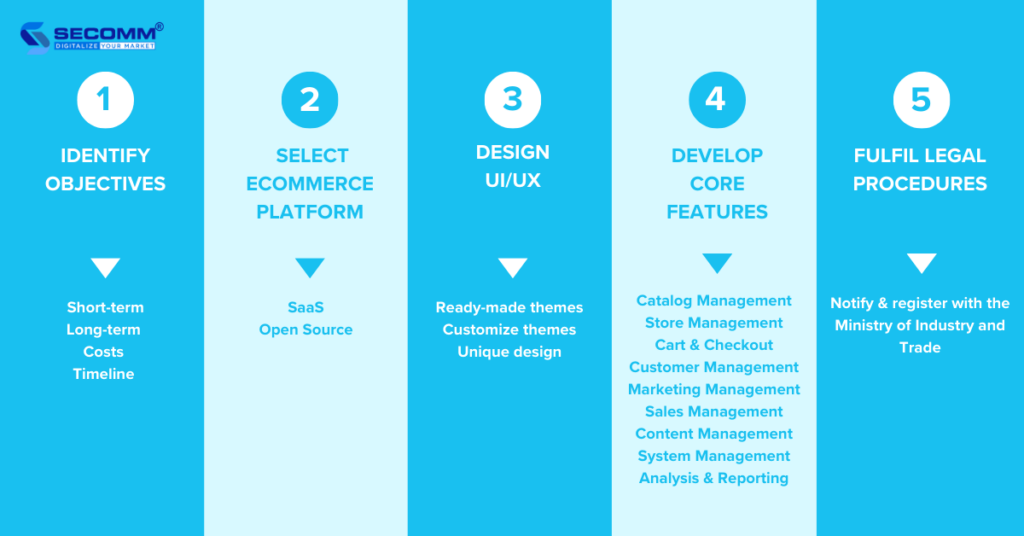
The first thing to do is identify and prioritize goals to plan the pharmacy eCommerce website development for each phase.
In the long run, businesses can consider goals like branding, generating potential customers, and optimizing online and offline operations.
For short-term goals, businesses should prioritize objectives like monitoring and analyzing customer behavior, evaluating marketing campaigns, and revenue growth.
In the first phase, businesses can decide to deploy quickly to enter the market or proceed gradually to test and adapt to this eCommerce world.
There are two types of platforms to help businesses facilitate pharmacy eCommerce websites: SaaS (Software as a Service) and open source.
Some popular SaaS eCommerce platforms include
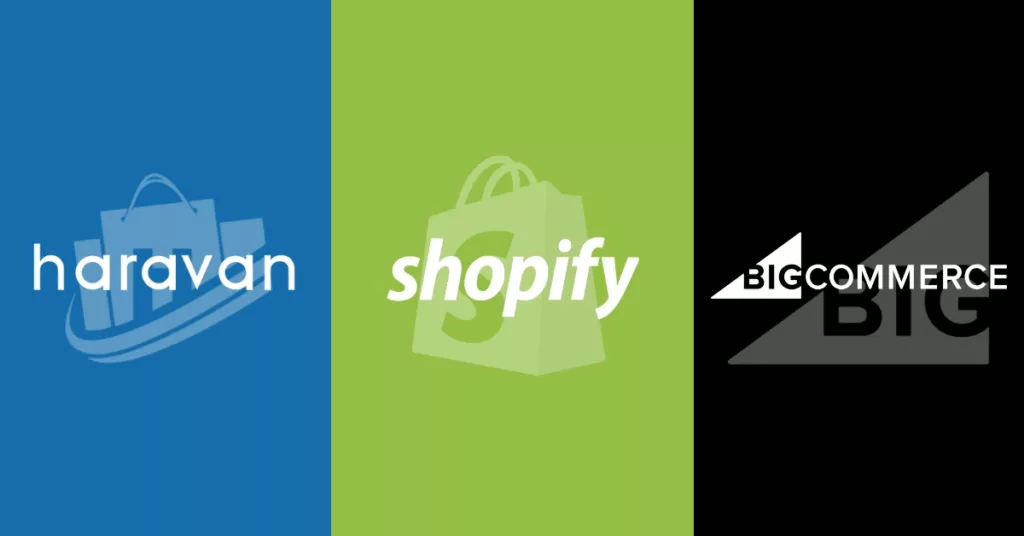
Some outstanding open-source eCommerce platforms include
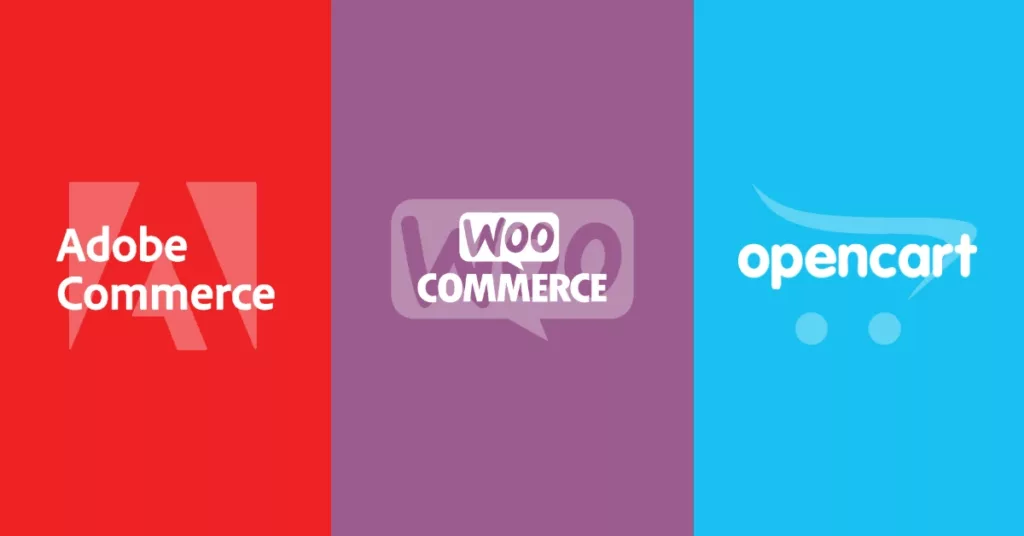
Typically, new eCommerce businesses will choose SaaS platforms to save time and budget in the initial phase of building a basic eCommerce website or an online pharmacy. Then, businesses will re-platform to an open-source platform to develop more advanced eCommerce systems.
However, some businesses decide to build their eCommerce websites in the basic phase on an open-source platform and then upgrade the system over time to remove the re-platforming step in the later phase.
When designing the interface, businesses need to meet basic criteria such as UI/UX standards, showcasing the brand’s characteristics, maintaining consistent product presentation, providing sufficient user guidance, etc.
When it comes to UI/UX design, it’s important to showcase the brand image, products, user guide, etc.
There are three ways to design UI/UX:
In this phase, businesses often choose ready-made themes to minimize costs, but some financially robust businesses may opt for the other two methods to better position their brand.
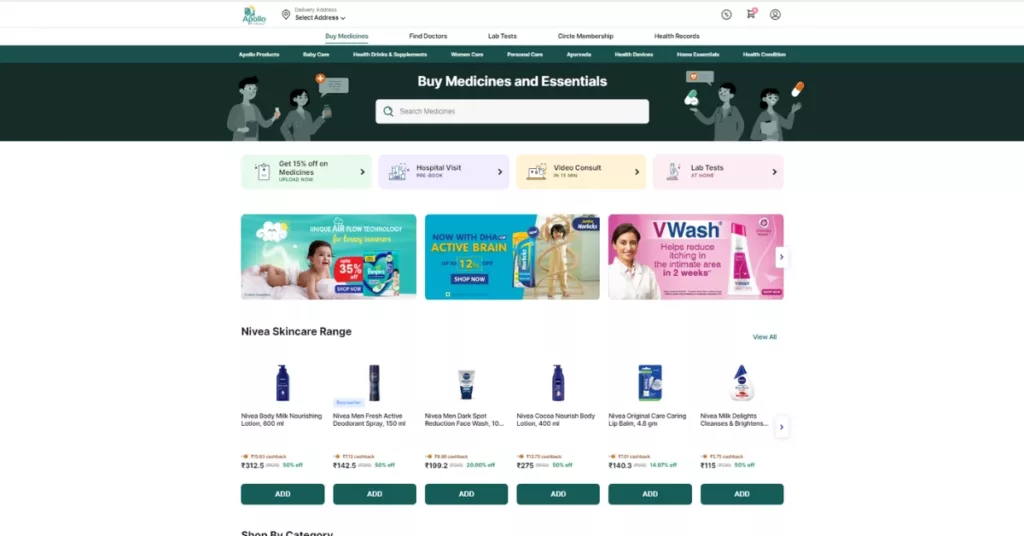
In the basic development phase, businesses should prioritize developing core features for an online pharmacy.
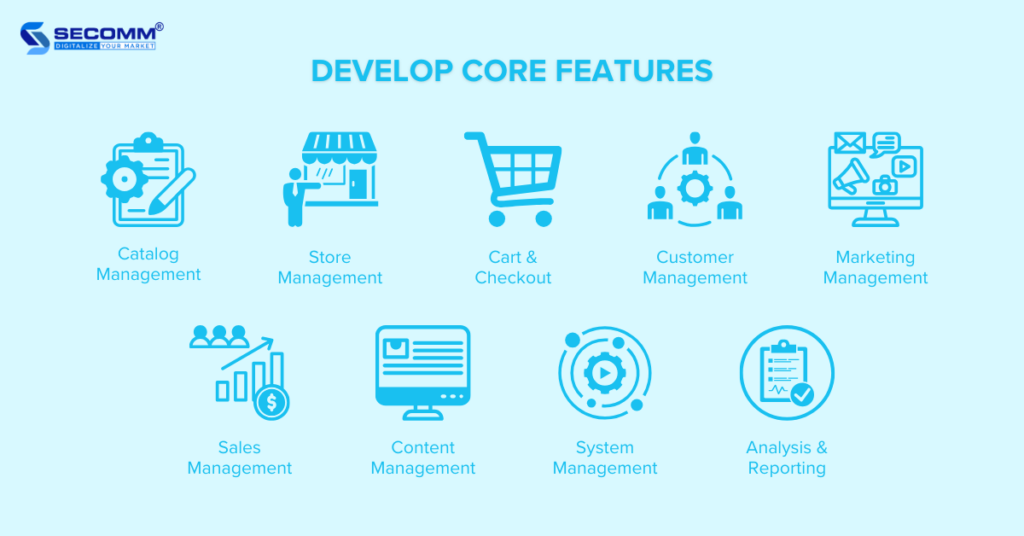
Some essential features that a pharmacy eCommerce website should have include
After developing features and ensuring a successful testing and website launch, businesses are obligated to complete the legal procedures associated with eCommerce operations.
According to Decree 52/2013/ND-CP by the Government of Vietnam, any individual or organization owning an e-commerce website for sales is required to notify or register with the Ministry of Industry and Trade through the online public service portal of the Ministry of Industry and Trade.
Note: Websites that operate beyond the specified period or fail to register/notify the authorized management agency within the designated timeframe may be subject to administrative penalties as per regulations.
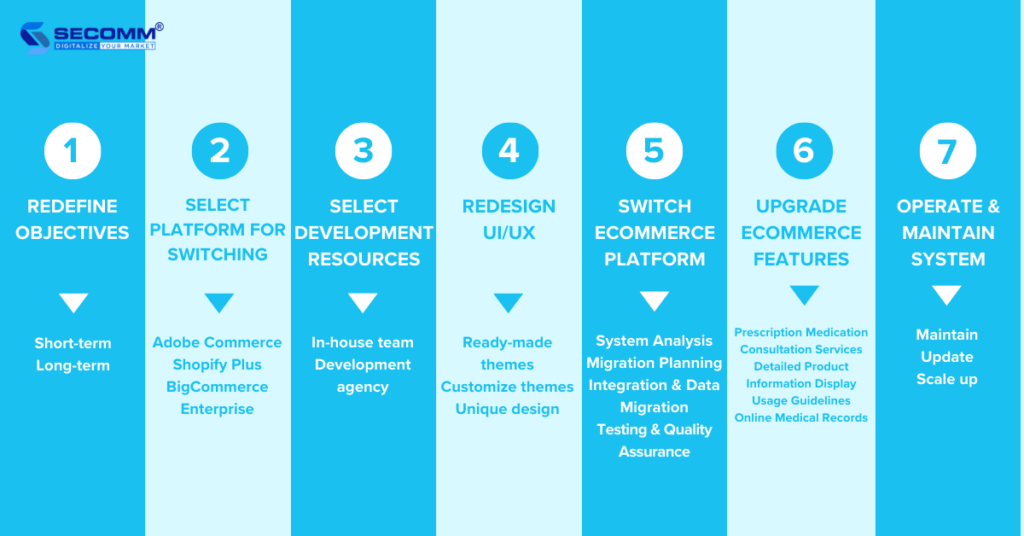
In the process of business development and amidst significant market changes, it’s important to realign goals to suit the evolving landscape. This time for business leaders to redefine objectives regarding the overall strategy, timeline, and budget for investing in the pharmacy eCommerce website.
During this phase, businesses often focus on short-term and long-term goals related to expanding the online pharmacy
For long-term goals, businesses may consider goals such as expanding market segments, establishing a loyalty program, and cultivating shopping habits for healthcare products, pharmaceuticals, and medical equipment.
For long-term goals, businesses may prioritize goals related to tapping into new potential customers, revenue growth, and supporting eCommerce marketing strategies such as livestreaming, gamification, affiliate marketing, and influencer marketing.
When SaaS platforms can’t support businesses to expand the system anymore, re-platforming to another robust platform is a top choice. Platforms like Adobe Commerce, Shopify Plus, and BigCommerce Enterprise can help businesses facilitate a deeply custom pharmacy eCommerce website.

When re-platforming, businesses have challenges such as switching costs, time to train personnel, and data loss throughout the platform migration process.
To build a high-complexity online pharmacy on a professional platform, businesses need resources to facilitate it effectively.
Businesses can decide to build an in-house team or seek a development agency. Regardless of the choice, it requires businesses to have practical experience on the selected platform.
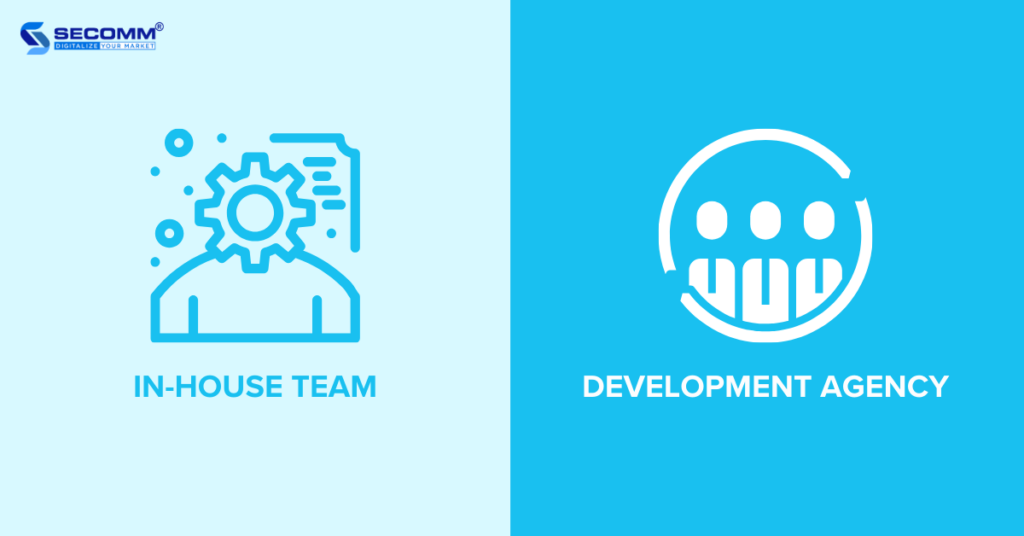
For building an in-house team, businesses need to recruit and train IT and eCommerce personnel to develop on the selected platform. This option may take time and budget to establish a high-performing team but it allows the business to have better control over resources and actively adjust or develop the website system.
In case businesses hire a development agency, here are some criteria to consider:
Partnering with a professional development agency will help businesses gain specialized knowledge, enhance experience, and create an online pharmacy tailored to the specific needs of the industry.
During the platform migration process, businesses can keep the current website design without making any changes. However, some businesses tend to redesign their websites to align with new strategies and the new platform.
Similar to the previous phase, businesses have three options to design their pharmacy eCommerce websites: using ready-made themes, customizing themes, or designing a unique interface.
However, in phase 2, businesses often decide to customize themes or design a unique interface to express the brand image and the pharmaceutical eCommerce industry.
After the right eCommerce platform for migrating, businesses should carry out the process to minimize the risk of data loss or errors. Typically, the migration process is automated as much as possible to avoid potential issues.
The migration process includes the following steps:
After re-platforming, the business needs to perform thorough checks to ensure that the data has been migrated completely and accurately according to the plan.
Beyond core features, businesses should focus on building a system with more complex features, including advanced and industry-specific functionalities for pharmaceutical eCommerce.
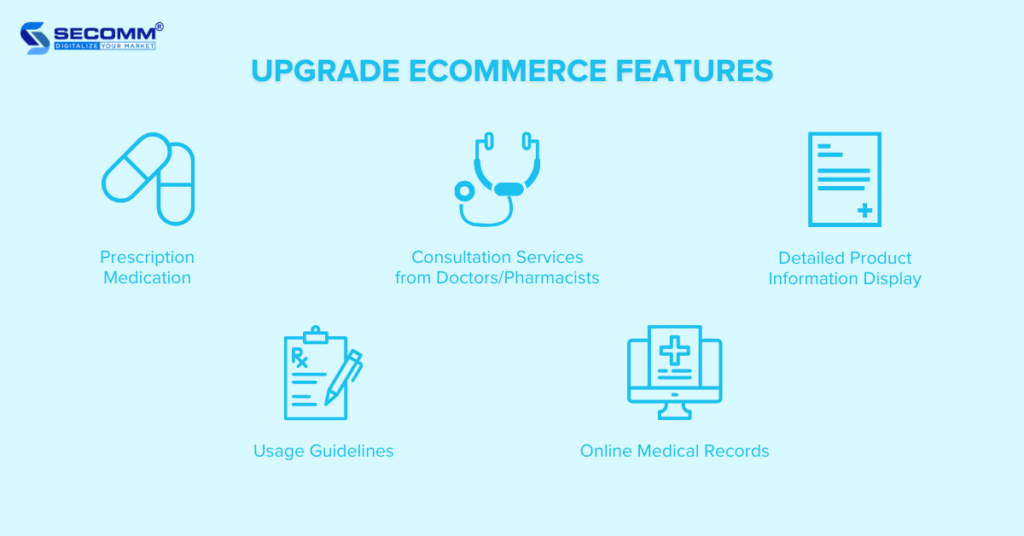
In addition, businesses need to consistently update and enhance these features to meet user needs and keep pace with market trends.
When testing the eCommerce system, businesses need to thoroughly check the entire website and its features over a specific period to ensure order processing speed and website stability. If any issues arise, businesses should immediately contact the in-house team or development partner to adjust and improve the website accordingly before officially going live.
Once the pharmacy eCommerce website system is stable, businesses should focus on eCommerce marketing strategies or Omnichannel approaches to enhance their online pharmacy.
Additionally, regular maintenance, updates, and continuous system upgrades are essential to sustain growth and quickly adapt to changes in the eCommerce market in general and the healthcare market in particular.
The Bottom Line
In general, the journey of building a pharmacy eCommerce website in Vietnam is not an easy task. This work demands substantial investments of time and budget from businesses to research the most suitable eCommerce strategy for each stage of their development.
Understanding the challenges that businesses may encounter when building an online pharmacy, SECOMM is ready to provide custom solutions for developing an eCommerce system.
Contact SECOMM or call the hotline at 028 7108 9908 for a free consultation.
 2
2
 6,604
6,604
 0
0
 1
1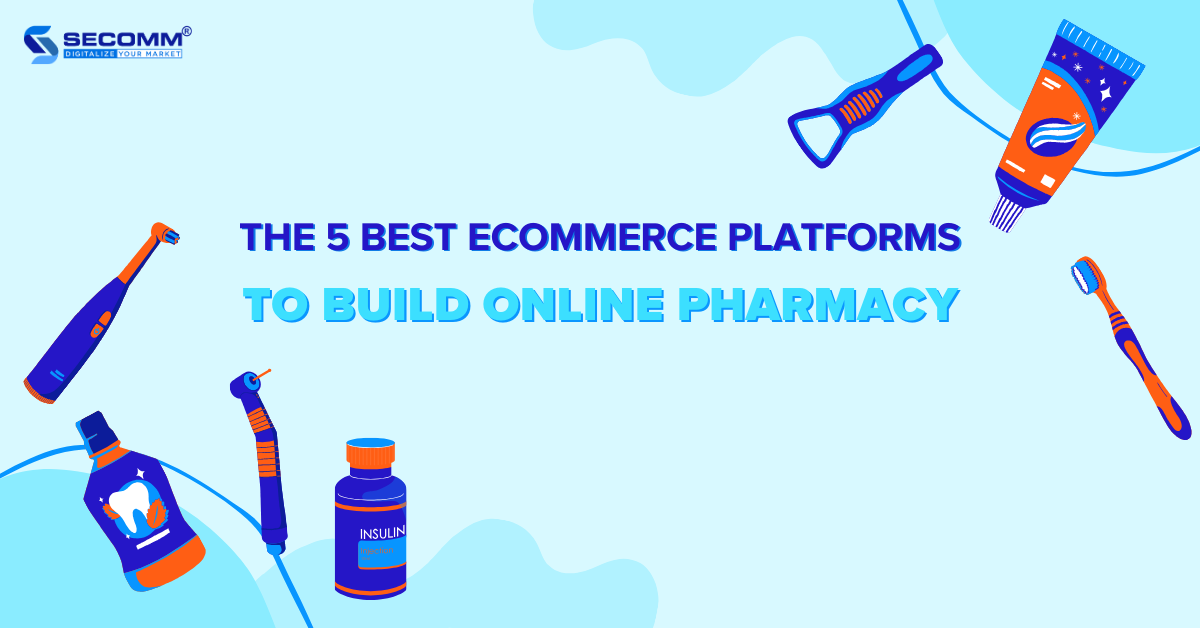
According to The Business Research Company, the global pharmaceutical eCommerce market is projected to reach $732.3 billion by 2027. This represents a significant opportunity for pharmacies, healthcare service providers, or hospitals/clinics to implement eCommerce and reach a broader range of potential customers. To achieve this, building an online pharmacy on a professional platform is a great idea to address industry-specific challenges.
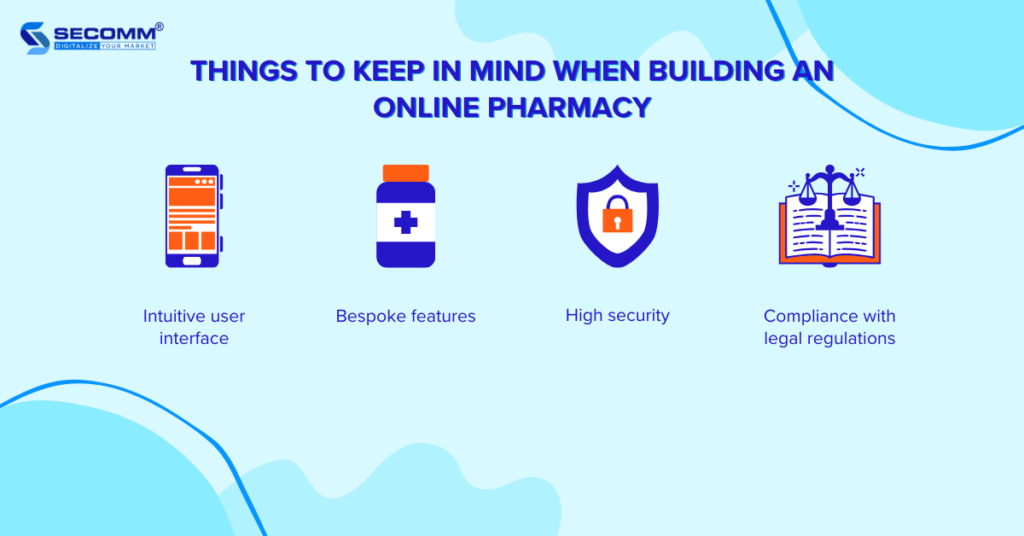
When building a pharmacy eCommerce website, businesses must meet numerous criteria to ensure professionalism, safety, and legal compliance within this industry.
The typical customer profile in the pharmaceutical eCommerce sector consists of individuals seeking to purchase medications, medical equipment, and other healthcare products for themselves, family, or friends.
Thus, the website interface needs to be visually appealing, and user-friendly, and prioritize colors such as blue or white to create a sense of safety and cleanliness.
Other factors, such as layout, font choice, and imagery, should be carefully selected and coordinated to deliver the most professional user experience.
When building an online pharmacy, beyond default eCommerce features, businesses should focus on developing the following features to address industry-specific needs:
An online pharmacy is a system that contains various crucial information including personal details, payment information, and the health status of customers. Therefore, the security system of the website needs to be built and deployed carefully to ensure the safety of customer data.
Pharmaceutical eCommerce is a specialized business area subject to the regulations of the healthcare/pharmaceutical industry. eCommerce pharmaceutical businesses need to comply with these regulations to ensure that their operations are legal and safe for customers.
Below are some key legal regulations that e-commerce pharmaceutical businesses need to adhere to in Vietnam:
In addition, pharmaceutical eCommerce businesses also need to comply with other legal regulations, such as Cybersecurity Law, Consumer Protection Law, and eCommerce Law.
Although this industry has many challenges to deploy, businesses always have eCommerce platforms to create their online pharmacies. Here are the 5 leading platforms for building online pharmacy that businesses may consider.
BigCommerce is a cloud-based eCommerce platform operating on the Software as a Service (SaaS) model, enabling businesses to create and manage online stores.
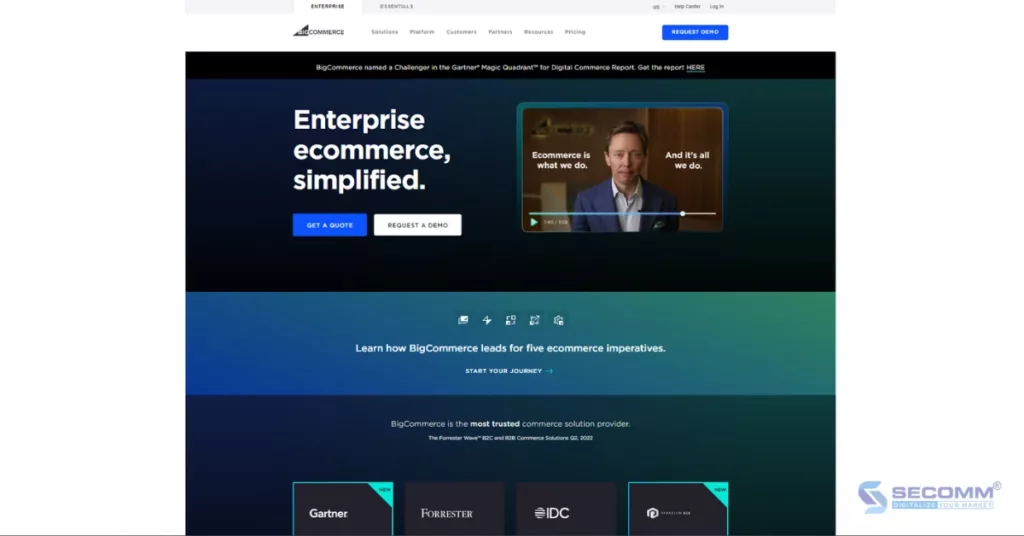
Currently, BigCommerce offers four main solutions, including
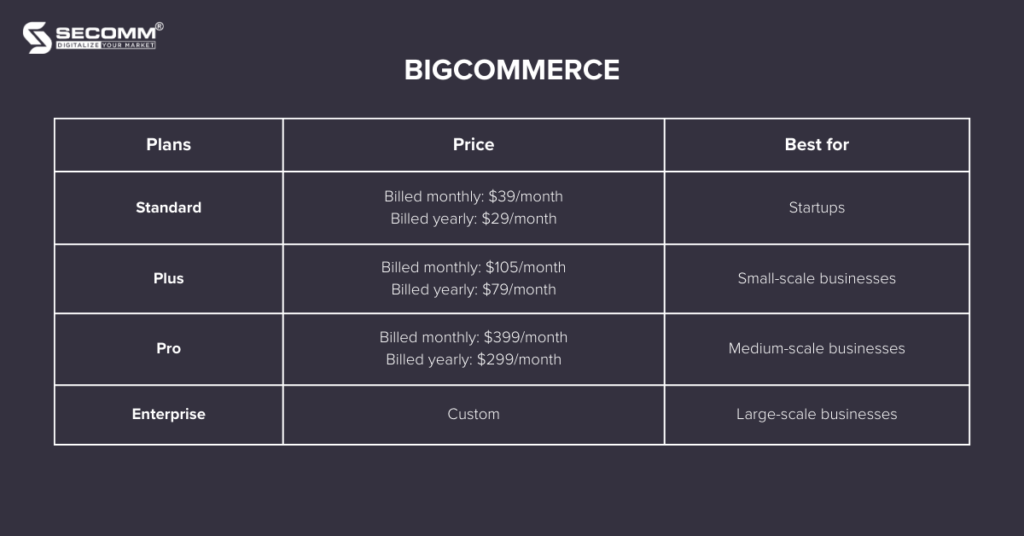
Pros:
Cons:
Some famous pharmaceutical eCommerce businesses currently utilizing BigCommerce include Victoria Health, Molton Brown, LARQ, and Zyppah.
Shopify is a SaaS eCommerce platform established in 2006. To date, Shopify has rapidly become one of the leading platforms in the eCommerce industry, supporting thousands of businesses worldwide to initiate and grow their online ventures.

The cost to use the Shopify platform is quite diverse, including these three solutions:
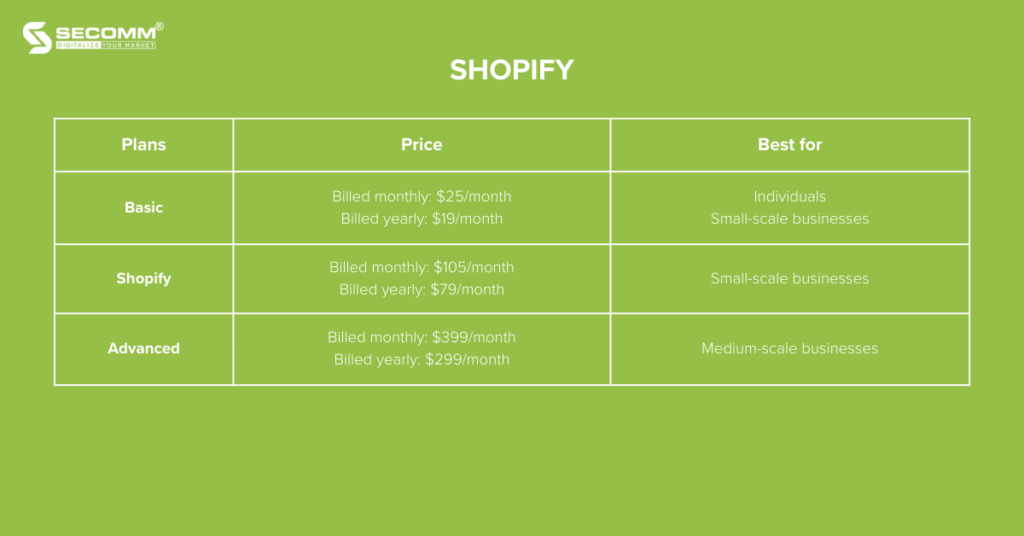
In addition, Shopify provides eCommerce solutions tailored to businesses with different needs and wants, such as:
Learn more: Top 5 benefits of Headless Commerce
Pros:
Cons:
Healthcare, pharmaceutical, and medical businesses using Shopify include Dr.Axe, 310 Nutrition, Hiya, and BUBS Naturals.
StoreHippo is a SaaS eCommerce platform established in 2014 in India. Over the years, this platform has consistently updated its technologies to meet the website-building needs of businesses, particularly those in the pharmaceutical eCommerce sector.
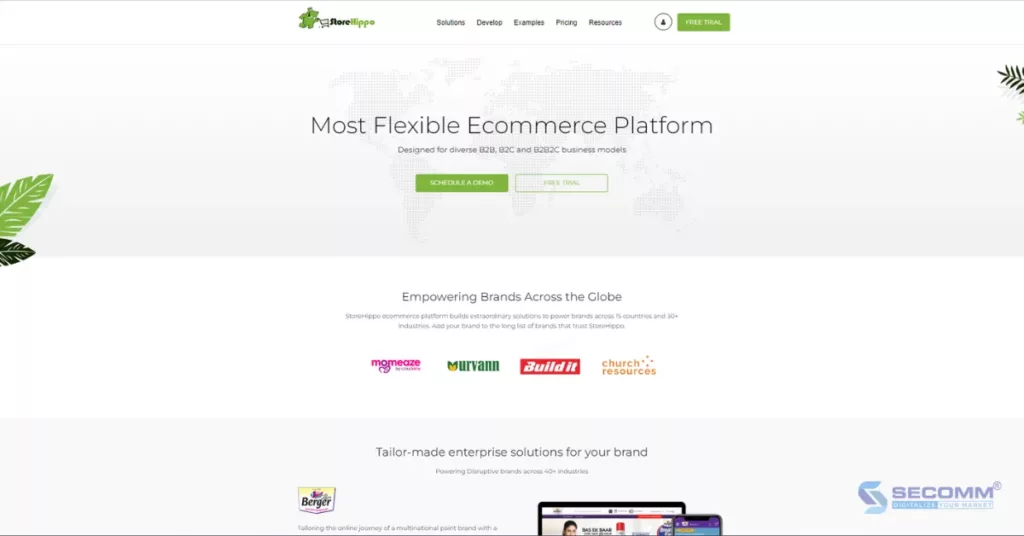
Similar to other SaaS platforms, StoreHippo offers a variety of solutions to choose from:
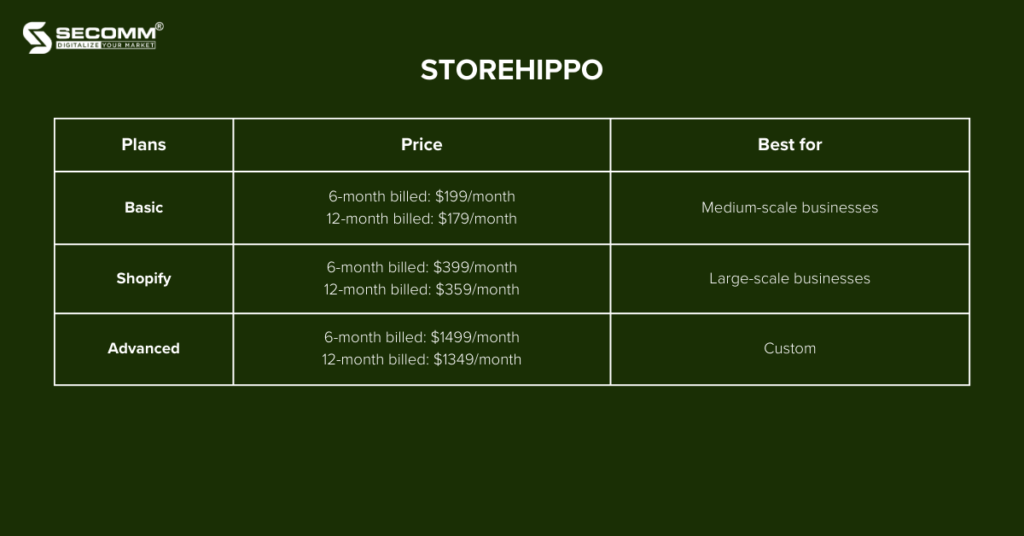
Pros:
Cons:
Some brands that built their online pharmacy with StoreHippo include WoundProfessional, Kunooz, and On A Healthy Note.
WooCommerce is an open-source eCommerce plugin developed for the WordPress platform, one of the most popular content management systems (CMS) globally. WooCommerce enables businesses to turn their WordPress websites into online stores or integrate eCommerce features into existing websites.
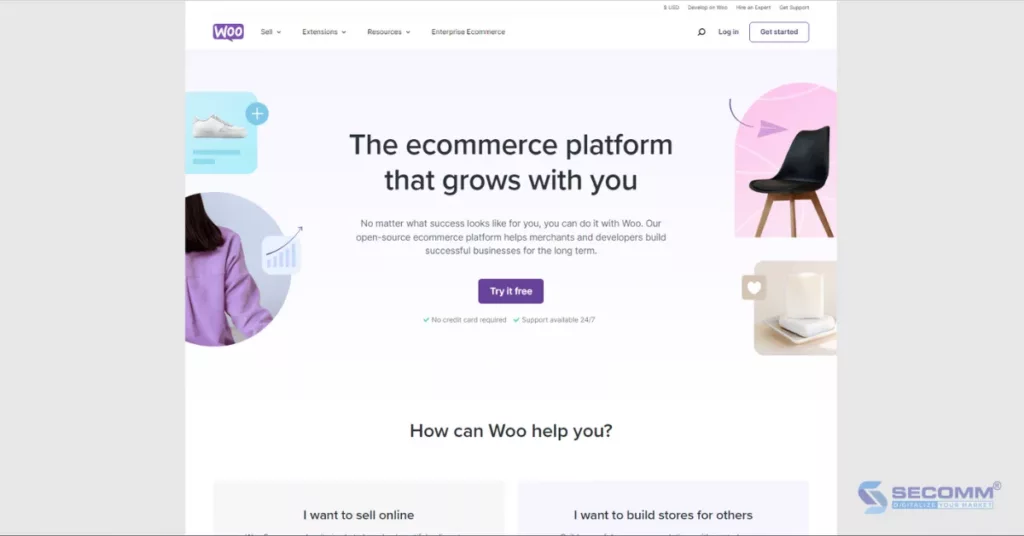
The license fee of WooCommerce depends on the complexity of each project, averaging around $1,000 for a basic eCommerce website and $10,000 for a more advanced eCommerce website.
Pros:
Cons:
Brands using WooCommerce to build online pharmacy include Dr. Scholl’s, myLAB Box, Superdrug Health Clinics, and Apothecanna.
Adobe Commerce, formerly known as Magento Commerce, is a professional and widely used eCommerce system. Adobe Commerce is part of the Adobe Experience Cloud product line and is designed to assist businesses in building eCommerce websites.
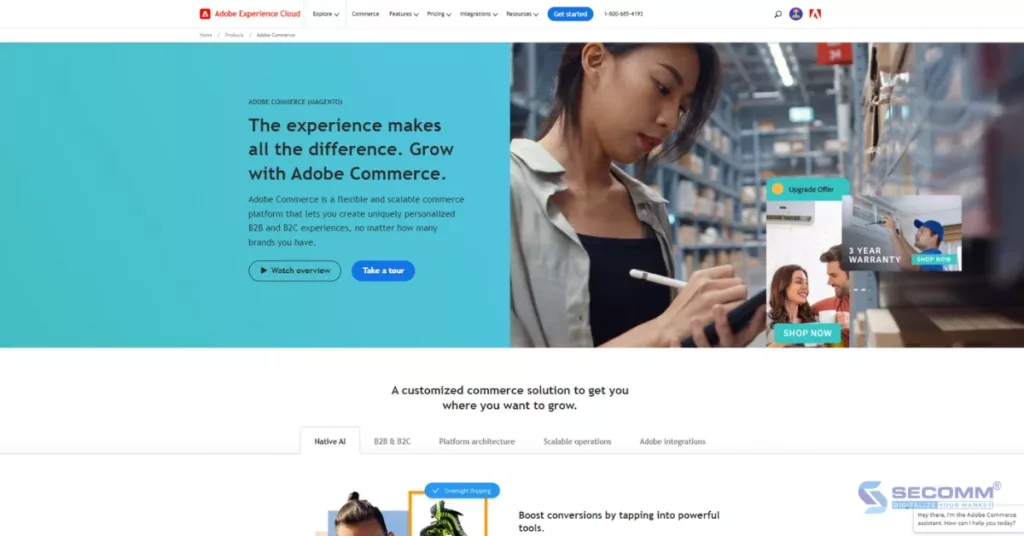
Currently, Adobe Commerce provides businesses with two main versions:
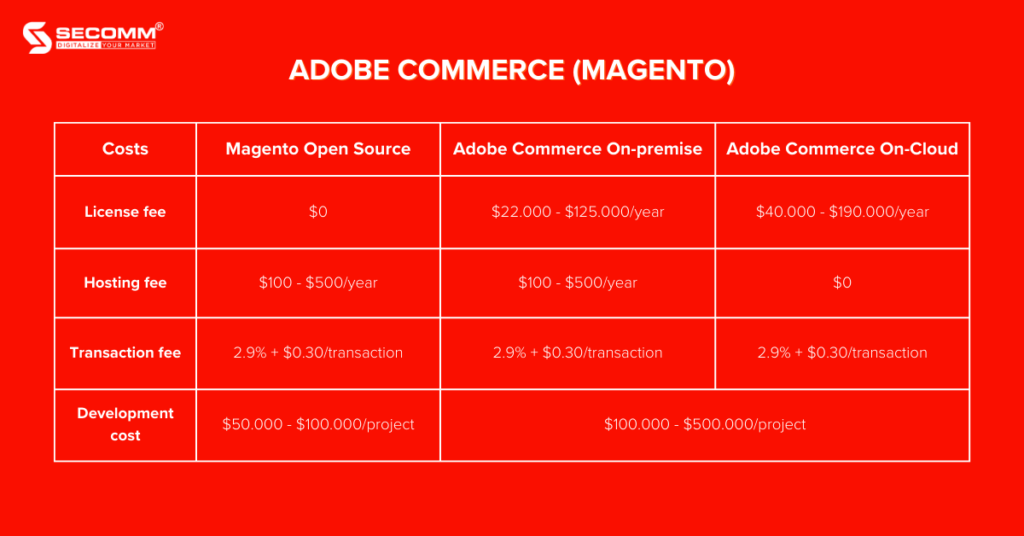
Pros:
Cons:
This list is just a few examples for businesses to reference; there are many other robust eCommerce platforms that businesses can consider based on specific needs and available resources.
With extensive experience in implementing eCommerce for clients in various countries, SECOMM understands the challenges and difficulties businesses face during the deployment of pharmaceutical eCommerce.
Contact SECOMM now or call the hotline at 02871089908 today for a free consultation.
 2
2
 8,791
8,791
 0
0
 1
1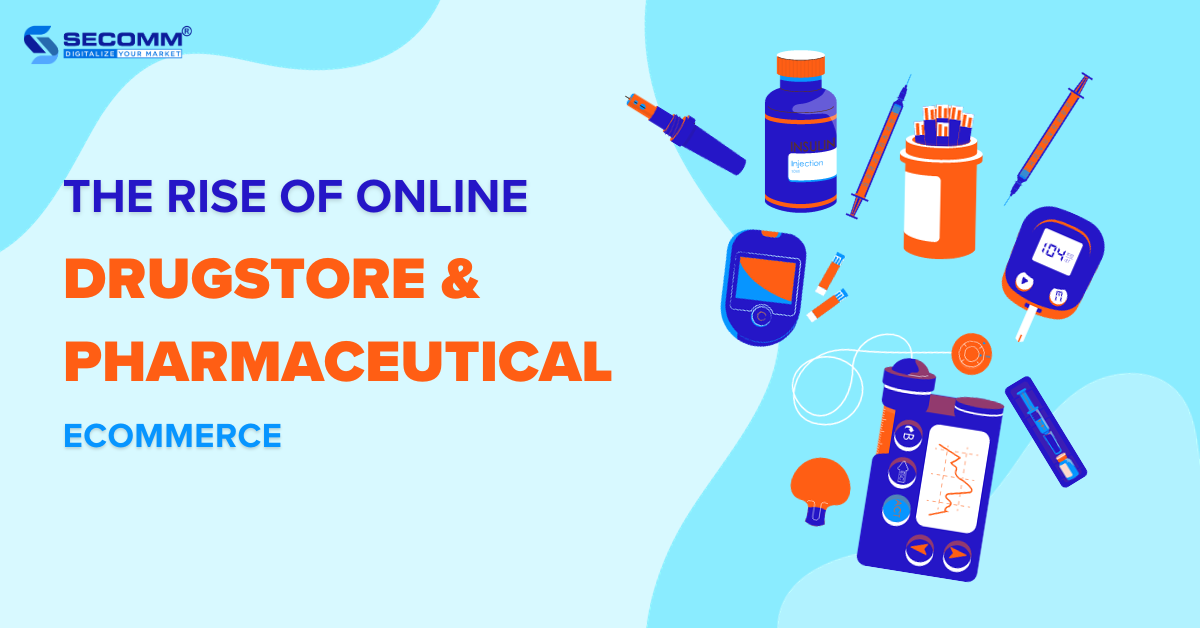
In the ever-growing digital age, online drugstores have become an ideal destination for global users seeking convenient and safe ways to care for their health and purchase medications online. The robust growth of eCommerce and changes in user behavior have driven the expansion of this pharmaceutical eCommerce industry.
Below are some crucial insights into why pharmaceutical eCommerce has become an essential component of the modern healthcare system.
Pharmaceutical eCommerce has become a promising business model in recent years. According to the “Healthcare eCommerce Global Market Report” compiled by The Business Research Company, pharmaceutical eCommerce is categorized into three main models:
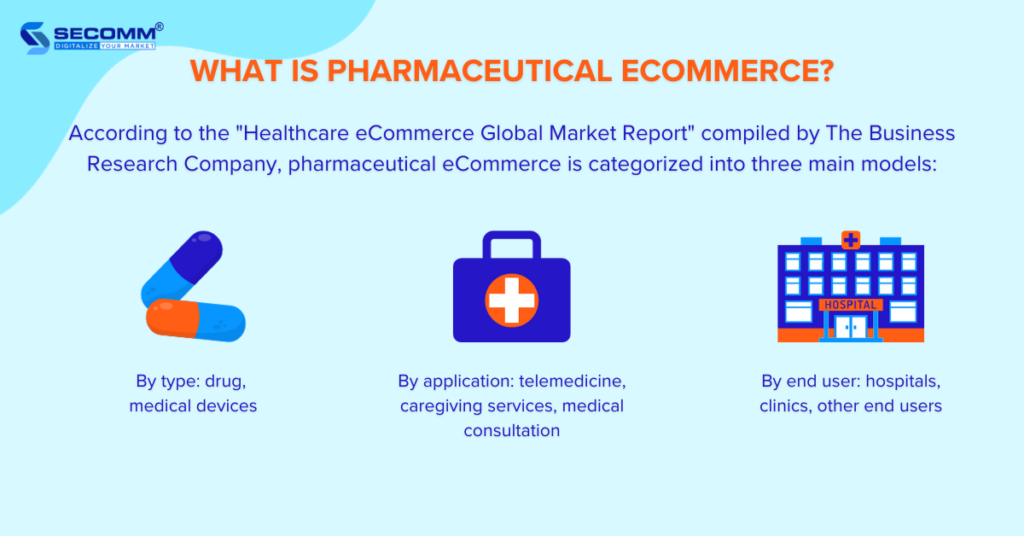
This is a model that enables consumers to order and purchase various products such as prescription drugs, over-the-counter medications, vitamins, dietary supplements, healthcare, personal care, etc., through online shopping channels.
Some well-known pharmaceutical eCommerce by type examples include Droga Raia (Brazil), Netmeds (India), Pharmacity (Vietnam), etc.
Consumers can access healthcare consultation, advice, and diagnostic services through various applications for this type of pharmaceutical eCommerce. Under this model, consumers typically subscribe to and pay for these services through packages or on a subscription basis (monthly or yearly).
Companies adopting this service-oriented eCommerce model include Teladoc (USA), iCliniq (India), SBB Healthcare (Vietnam), and others.
This pharmaceutical eCommerce model often involves websites or applications created by hospitals/clinics to assist patients in scheduling appointments, offering healthcare packages, prescription medications, and more.
Examples of hospitals/clinics following the eCommerce model by end-users include The Royal Melbourne Hospital (Australia), NYC Health+ Hospital (USA), Vinmec (Vietnam), and others.
Certainly, Covid has not only led to a rise in traditional healthcare expenditures but has also acted as a driving force for pharmaceutical eCommerce. In the United States, telehealth visits witnessed a remarkable surge of 2,600% in March 2020 (during the peak of the COVID-19 outbreak in the U.S.) compared to the same month in 2019.
The growth of the pharmaceutical eCommerce market seems unabated. According to a recent report by CMS, total healthcare spending in the United States reached $3.8 trillion, marking a 4.6% increase in 2022. The Asia-Pacific region is anticipated to experience rapid growth in healthcare eCommerce, with a projected CAGR of 20.5% from 2020 to 2027.
Nielsen predicts that the pharmaceutical eCommerce market in Vietnam will attain a value of $10 billion by 2025.
Some other reasons for the rise of pharmaceutical eCommerce include:
Apollo Pharmacy is a well-known retail pharmacy chain in India, affiliated with the Apollo Hospitals. After years of operation in the healthcare sector, Apollo decided to establish an eCommerce website to serve millions of customers nationwide. The Apollo eCommerce website is built on the Magento platform, ensuring the capability to manage an extensive product catalog.
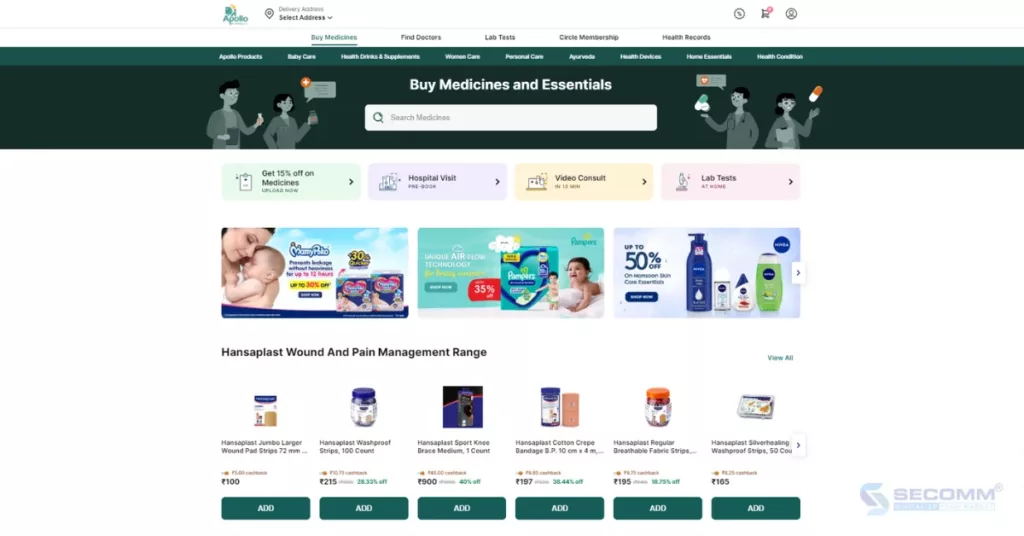
Beyond selling prescription and non-prescription drugs, as well as health care products, Apollo also provides various related services. Among these, notable offerings include online consultation services, health check-up appointments, vaccination appointments, and insurance sales.
Teladoc Health, Inc. is an American healthcare technology company headquartered in Purchase, New York. The company provides remote healthcare services, including video consultations, phone consultations, and remote health monitoring.
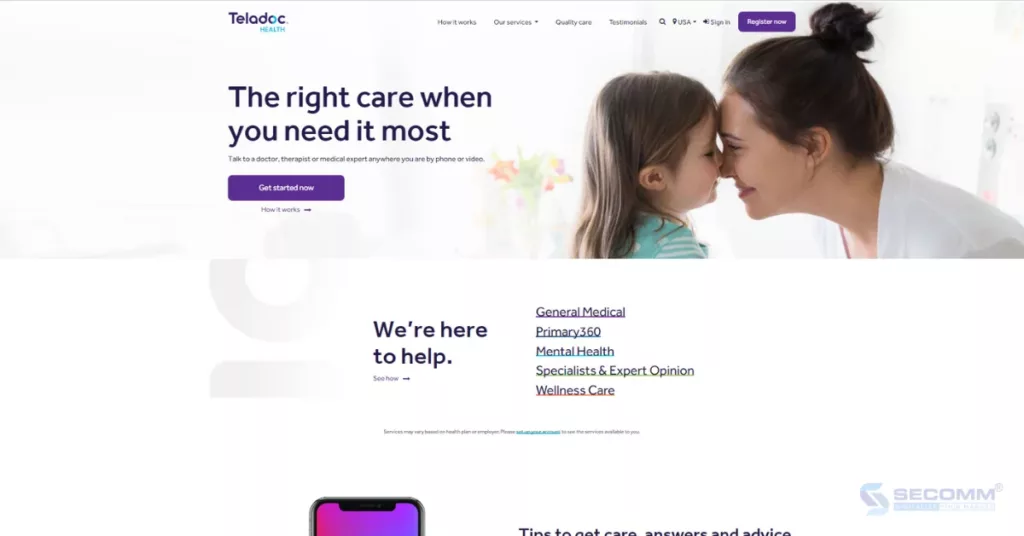
By rapidly deploying a website and eCommerce application, along with the utilization of cutting-edge technologies such as artificial intelligence (AI), machine learning (ML), and data analytics, Teladoc has been able to enhance customer experience and deliver improved remote healthcare services.
Mayo Clinic was founded in 1889 by Dr. William W. Mayo and his two sons, Dr. Charles and Dr. William J. Mayo. Initially, Mayo Clinic was a small clinic specializing in providing healthcare services to the local community. However, the hospital quickly expanded and became one of the leading hospitals in the world.

Much of Mayo Clinic’s success can be attributed to the early adoption of eCommerce, allowing patients to schedule appointments, check test results, and purchase medications online. This has helped patients save time and effort, contributing to Mayo Clinic’s overall success.
Learn more: The 10 Best Remarkable Pharmacy eCommerce Websites
The Bottom Line
Pharmaceutical eCommerce not only brings convenience and diverse choices for consumers but also presents attractive business opportunities for healthcare enterprises. If invested systematically and guided correctly, businesses in this field can seize significant opportunities in this promising market.
With extensive experience in implementing eCommerce for customers in various countries, SECOMM understands the difficulties and challenges that businesses face during the deployment process.
Contact SECOMM now or call directly at the hotline number (02871089908) today for a free consultation
 2
2
 13,725
13,725
 0
0
 1
1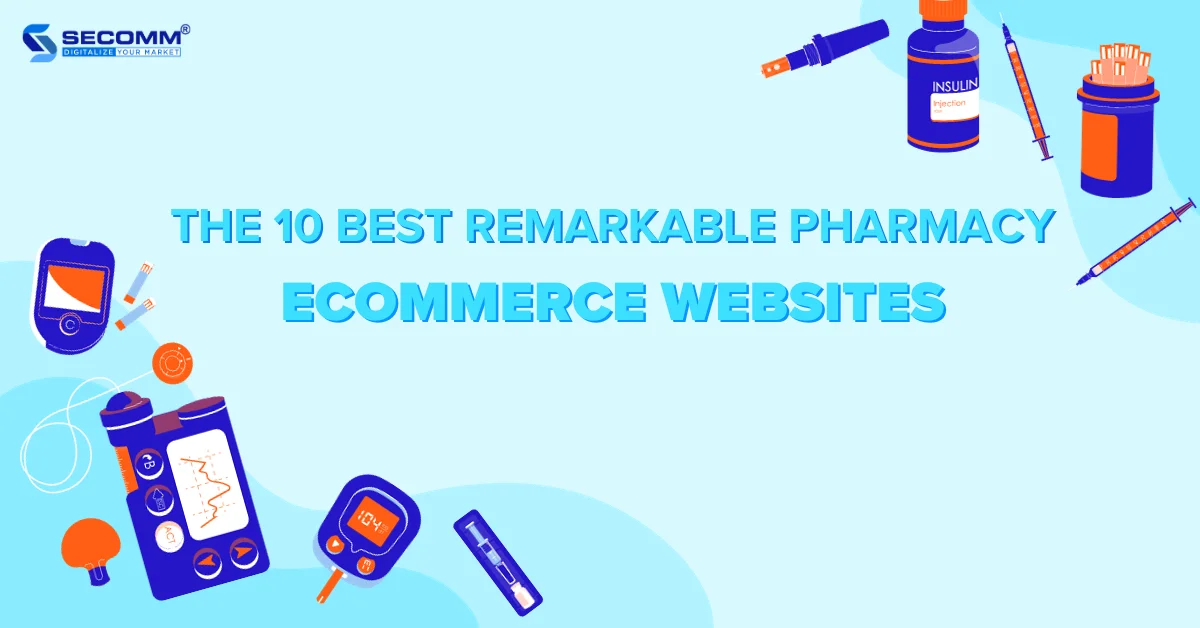
The eCommerce trend has quickly extended to various sectors of the economy. The explosion of online pharmacies, both domestically and internationally, demonstrates the significant impact this trend is having on the pharmaceutical industry.
Typically, the first step in the online presence strategy of these pharmacies is the professional establishment of an eCommerce website.
Here are 10 pharmaceutical brands in Vietnam and on the global stage that have effectively launched eCommerce websites and swiftly captured a significant share of this market.
CVS Health is a major player in the U.S. healthcare sector and stands as the largest retail pharmacy chain in the country, boasting over 9,900 physical stores. CVS also offers an array of healthcare services, encompassing general health check-ups, diagnostics, and dental care.
The CVS pharmacy eCommerce website is built upon the Oracle Commerce platform, equipped with numerous features to ensure an optimal user experience and scalability for the future. Notably, it includes a prescription management feature that empowers customers to oversee their prescriptions through their CVS accounts, request prescription refills, and receive medication deliveries at their doorstep. Furthermore, the online drugstore allows customers to schedule appointments with two options: in-person clinic visits or remote telehealth consultations via video calls.
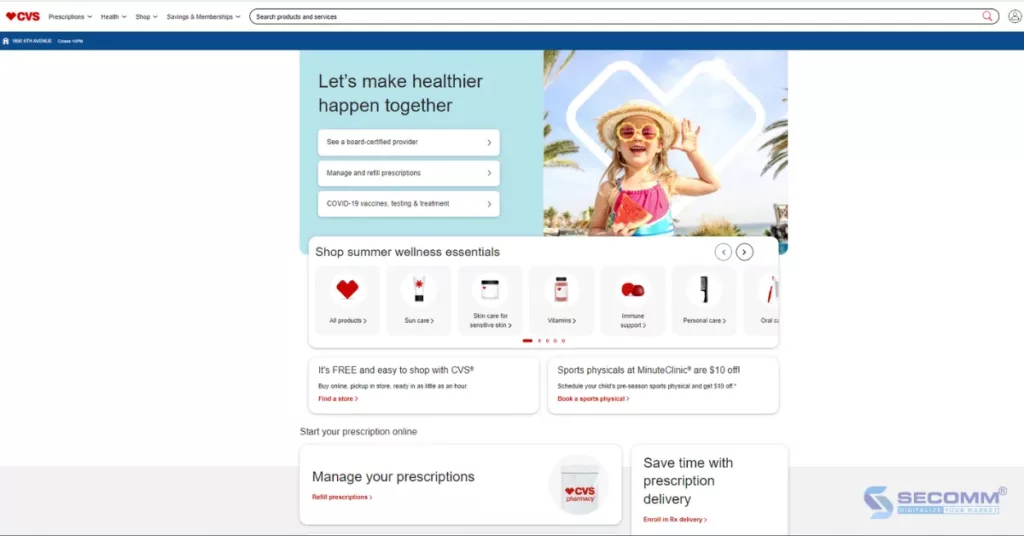
Established in 1890, Droga Raia has continually grown and, over the years, has become one of the foremost pharmacy chains in Brazil. Despite its long-standing legacy, Droga Raia hasn’t lagged in the eCommerce trend.
With an average monthly website traffic of 19.8 million, Droga Raia opted for Magento to facilitate its pharmacy eCommerce website. This choice was well-founded, given the platform’s superior flexibility for customization and scalability, ensuring the capability to manage high traffic volumes and cater to future system expansion needs.
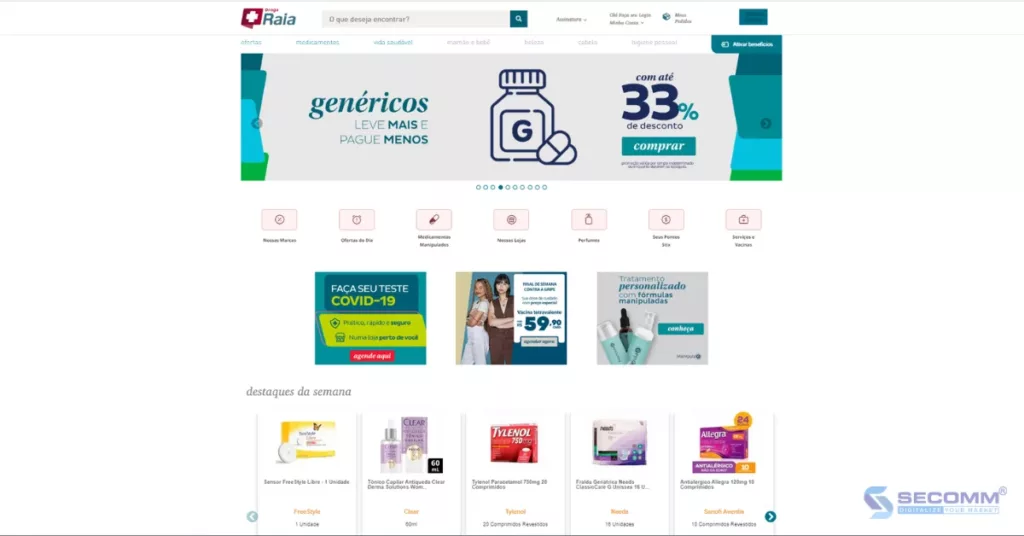
Apollo Pharmacy, a well-known retail pharmacy chain in India, operates as a subsidiary of Apollo Hospital. Over the years, Apollo has expanded its chain of stores to thousands, serving cities and towns across India.
Apollo built its online pharmacy on the Magento platform, equipped to manage a vast product portfolio. In addition to offering both prescription and non-prescription medications, as well as healthcare products, Apollo provides various related services. These services encompass online consultations, health check-up appointment scheduling, vaccination bookings, and insurance sales. Currently, the website garners 12.7 million monthly visits.
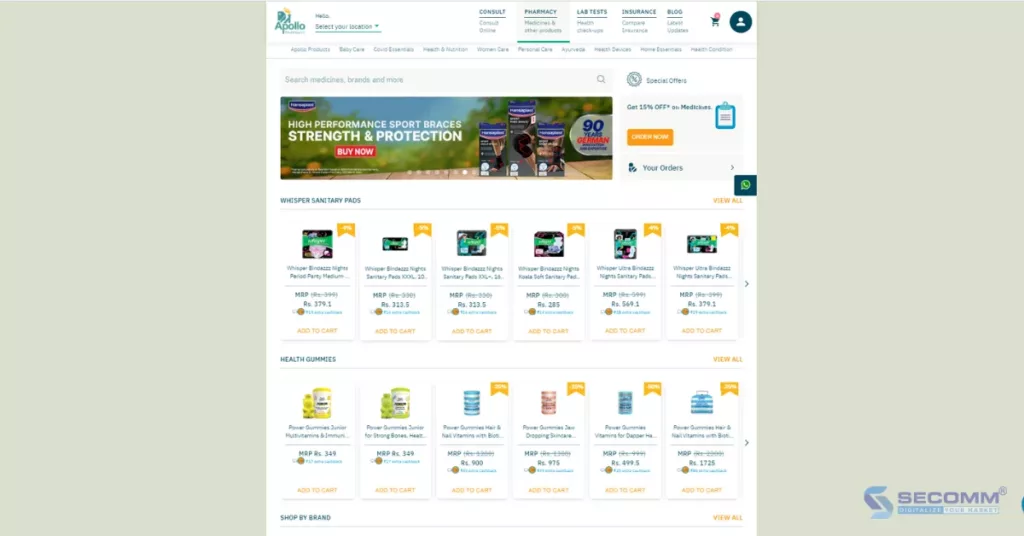
Another well-known online drugstore in India is Netmeds. In addition to prescription and non-prescription drugs, this brand offers a diverse range of healthcare products, including items for maternity and baby care, medical equipment, and dietary supplements for fitness enthusiasts, vegetarians, and those with diabetes. Netmeds also relies on Magento to develop its pharmacy eCommerce website, featuring various capabilities to enhance the user experience. These include product categorization with accompanying images, non-prescription product search recommendations, real-time product availability checks at specific stores, prescription upload options, and home delivery requests. At present, Netmeds’ website averages around 10.4 million monthly visits.
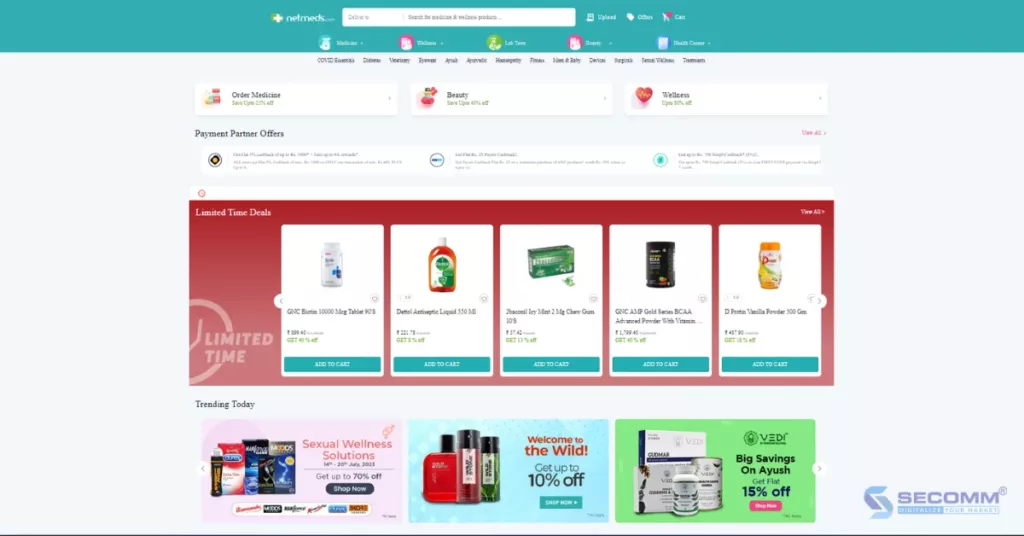
Nahdi Online is the leading pharmacy eCommerce website in Saudi Arabia and ranks among the region’s largest retail pharmacy chains. This marks the fourth pharmacy on the list utilizing the Magento platform to craft a user-friendly website enriched with advanced features, facilitating product-specific searches, in-depth product descriptions, and price comparisons for customers. Moreover, through Nahdi’s online pharmacy, users can access various online consultation and healthcare services or book appointments at the clinic.
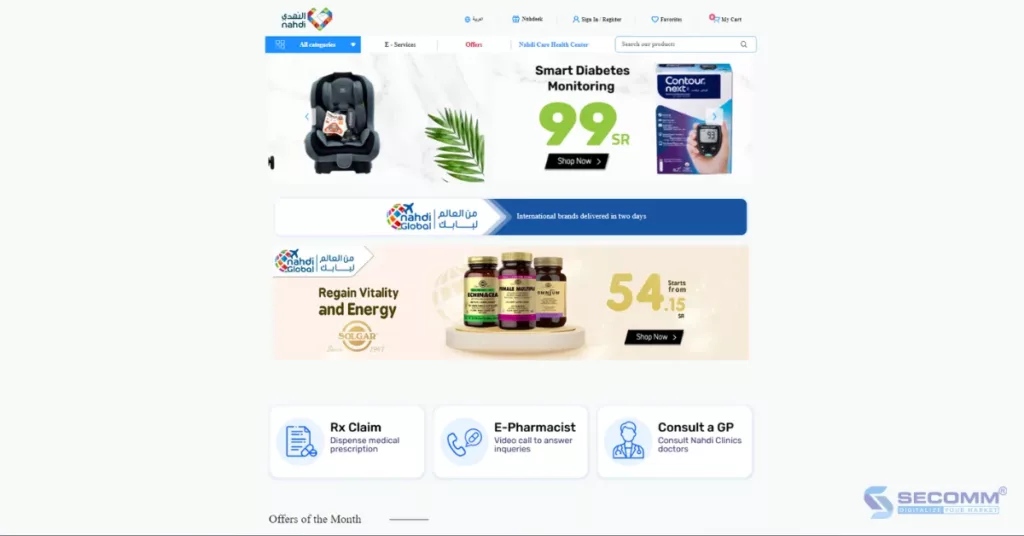
An Khang Pharmacy, one of the most trusted pharmacy chains in Vietnam, was established in 2012 and has since expanded to over 500 pharmacies nationwide. Additionally, the brand has introduced a pharmacy eCommerce website and a mobile app to cater to consumers’ online pharmaceutical needs, complete with a variety of enticing offers.
An Khang provides a wide array of products, including medications, dietary supplements, medical equipment, personal care items, and cosmetics. Moreover, the An Khang website features a dedicated section for disease lookup, allowing customers not only to make purchases but also to access information on various common diseases, including their causes, symptoms, treatment methods, and prevention.

FPT Long Chau, established in 2015, has a presence in over 1,000 stores across all 63 provinces in Vietnam and is a pioneer in the modern online pharmacy model. Both its pharmacy eCommerce website and app have gained strong favor from consumers for their rich and seamless shopping experience.
Notably, Long Chau leads the way in offering a Buy Now, Pay Later service with 0% interest, helping to ease the financial burden on patients. Furthermore, customers can access guidance from Long Chau’s experienced pharmacists through a hotline or chat service. Currently, the Long Chau website attracts approximately 5.2 million monthly visitors.
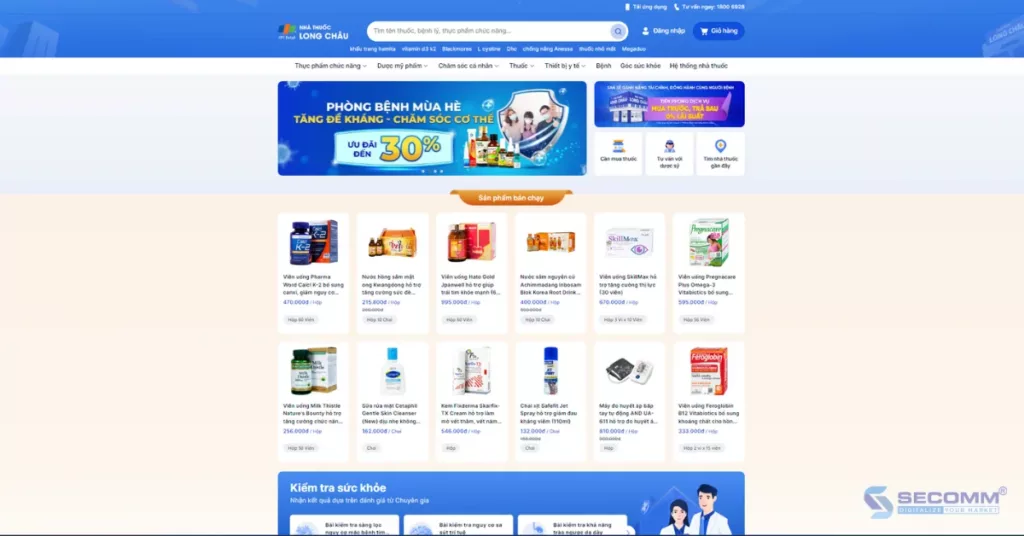
In the pharmaceutical market of Vietnam, Pharmacity is the third name mentioned in the fierce “three-horse race” taking place in both the online and offline channels. This company was founded in 2011 and currently has over 1,000 stores nationwide. Similar to An Khang and Long Chau, Pharmacity has also launched an eCommerce website and app with various promotional programs to provide customers and patients with a convenient and quick shopping experience, along with online consultation services from a team of highly professional pharmacists. Currently, the Pharmacity website attracts an average of 2.7 million monthly visitors.
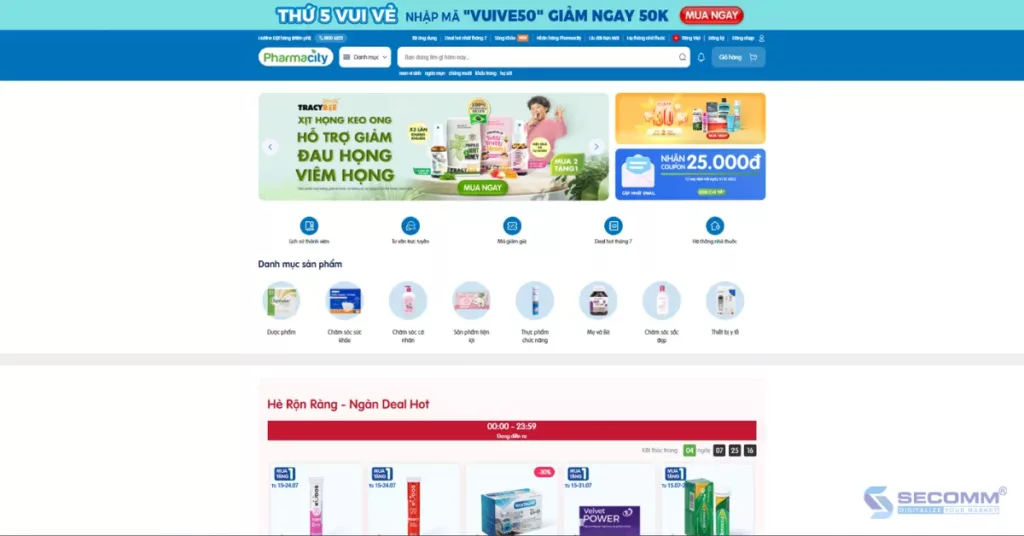
This is one of the most reputable and high-quality online pharmacy systems in Vietnam. The pharmacy offers a wide range of genuine pharmaceutical products, dietary supplements, health, and beauty care items from major global brands. Central Pharmacy’s drugstore provides various features to enhance the shopping experience for customers, such as search suggestions, search filters, and integration of messaging applications (FB Messenger and Zalo) on the website for customer support, prescription uploads, and home delivery requests. To date, the website has attracted more than 587,000 monthly visitors.
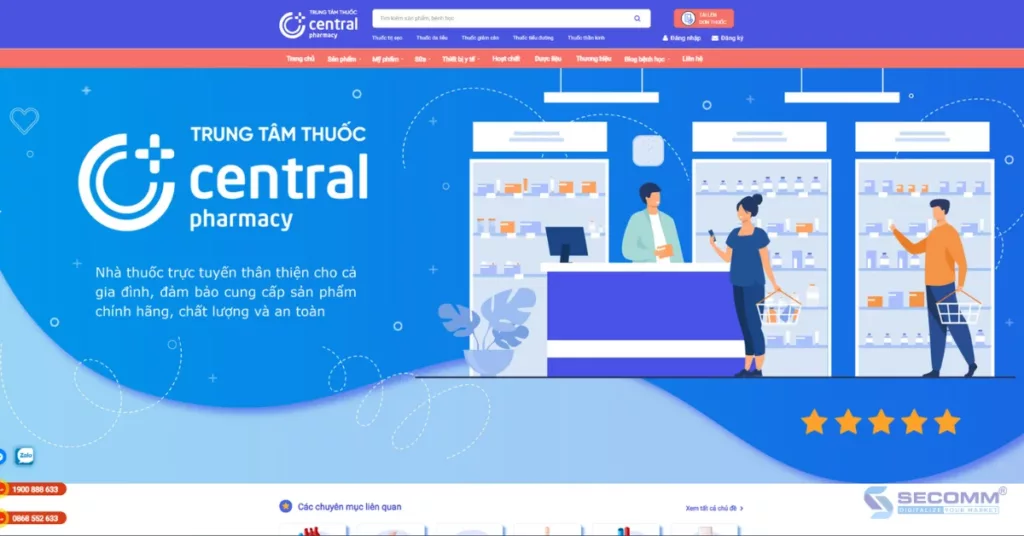
Nha Thuoc Than Thien is a retail chain that meets GPP standards in Vietnam. Specializing in prescription and over-the-counter medications, as well as various healthcare products, this establishment has embraced a hybrid model, combining both offline and online pharmacy services. The primary sales channel is its user-friendly eCommerce website, developed using WooCommerce. The website is intuitively designed, incorporating essential features to facilitate customer product searches, seamless transactions, and order tracking. With around 410 thousand monthly visits, the website continues to serve a significant audience.
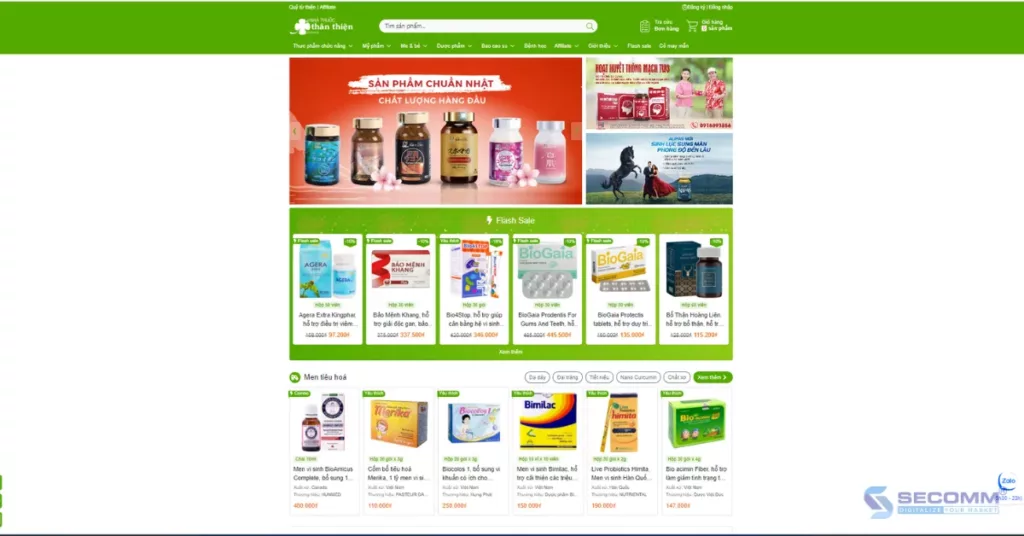
Here are the top 10 eCommerce websites, including leading online pharmacies, in both the Vietnamese and international markets. These brands demonstrate their adaptability to consumer trends and their efforts in developing technological infrastructure to compete in the multibillion-dollar market.
With a wealth of experience in successfully implementing eCommerce solutions for numerous clients across various countries in recent years, SECOMM specializes in providing consulting services with professional eCommerce deployment solutions tailored to the specific needs of each industry.
Feel free to contact or call SECOMM’s hotline directly at (02871089908) for a free consultation.
 2
2
 13,122
13,122
 0
0
 1
1Subscribe to get the latest eBook!
Hotline